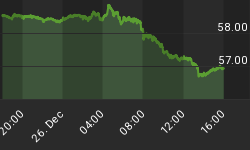The market gyrations of late are interesting. Higher volatility not only implies that lower prices are appropriate in theory but it also tends to happen in practice: higher actual volatility tends to force leveraged traders to reduce position size because their calculation of “value at risk” or VAR generally uses trailing volatility; moreover, these days we also need to be cognizant of the small, but still relevant, risk-parity community which will tend to trim the relative allocation to equities when equity volume rises relative to other asset classes.
My guess is that the risk-parity guys probably respond as much to changes in implied volatility as to realized volatility, so some of that move has already happened (and it’s not terribly large). But the VAR effect is entirely a lagging effect, and it’s proportional to the change in volatility as well as to the length of time the volatility persists (since one day’s sharp move doesn’t change the realized volatility calculation very much). Moreover, it doesn’t need to be very large per trader in order to add up to a very large effect since there are many, many traders who use some form of VAR in their risk control.
Keep in mind that a sharp move higher, as the market had yesterday, has as much effect on VAR as a sharp move lower. The momentum guys care about direction, but the VAR effect is related to the absolute value of the daily change. So if you’re bullish, you want a slow and steady move higher, not a sharp move higher. Ideally, that slow and steady move occurs on good volume, too.
The underlying fundamentals, of course, haven’t changed much between Friday and Monday. The chance of a trade war didn’t decline – the probability of a trade war is now 1.0, since it has already happened. Unless you want to call an attack and counterattack a mere skirmish, rather than a trade war, there is no longer any debate about whether there will be conflict on trade; the only discussion is on magnitude. And on that point, nothing much has changed either: it was always going to be the case that the initial salvo would be stridently delivered and then negotiated backwards. I’m not sure why people are so delighted about the weekend’s developments, except for the fact that investors love stories, and the story “trade war is ended!” is a fun story to tell the gulli-bulls.
As a reminder, it isn’t necessary to get Smoot/Hawley 2.0 to get inflation. Perhaps you need Smoot/Hawley to get another Depression, but not to get inflation. The mere fact that globalization is arrested, rather than continuing to advance, is enough to change the tradeoff between growth and inflation adversely. And that has been in the cards since day 1 of the Trump Administration. A full-on trade war, implying decreased globalization, changes the growth/inflation tradeoff in a very negative way, implying much tighter money growth will be required to tamp down inflation, which implies higher interest rates. I’m not sure we aren’t still headed that way.
But there is a much bigger issue on trade, which also implies higher interest rates…perhaps substantially higher interest rates. We (and by ‘we’ I mean ‘he’) are trying to reduce the trade deficit while increasing the budget deficit sharply. This can only happen one way, and that is if domestic savings increases drastically. I wrote about this point first in 2010, and then re-blogged it in 2013, here. I think that column is worth re-reading. Here’s a snippet:
“And this leads to the worry – if the trade deficit explodes, then two other things are going to happen, although how much of each I can’t even guess: (I) protectionist sentiment is going to become very shrill, and fall on the ears of a President who is looking to burnish his populist creds, and (II) the dollar is going to be beaten like a red-headed stepchild (being a red-headed stepchild, I use that simile grudgingly).” Well, it took a while to happen and I never dreamed the “President looking to burnish his populist creds” would be a (supposed) Republican…but that’s what we have.
Related: The World’s Biggest Investors Have Lost $436 Billion In 2018
Here’s the updated chart showing the relationship between these two variables.

(Click to enlarge)
It’s important to remember that you can’t have a trade account surplus and a financial account surplus. If someone sells a good to a U.S. consumer, that seller holds dollars and they can either sell the dollars to someone else (in which case the problem just changes hands), buy a U.S. good (in which case there’s no trade deficit), or buy a U.S. security. If we need non-U.S. persons to buy U.S. securities, then we need to run a trade deficit. If we want to run flat on trade, then we either need to run a balanced budget or fund the difference out of domestic savings. A large increase in domestic savings implies a large decrease in domestic spending, especially if the Fed is now ‘dissaving’ by reducing its balance sheet. Inducing extra domestic savings also implies higher real interest rates. Now, this isn’t a cataclysmic result – more domestic savings implies more long-term domestic growth, although perhaps not if it’s being sopped up by the federal government – but it’s a very large shift to what the current balances are.
If you want to run a flat balance of trade, the best way to do it is to run a balanced federal budget. Going opposite directions in those two accounts implies uncomfortably large shifts in the account that makes up the difference: domestic savings, and large shifts in interest rates to induce that savings.
By Michael Ashton via E-piphany
More Top Reads From Safehaven.com:

















